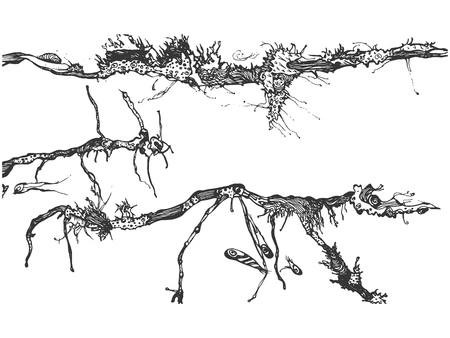1. Roots in Ancient Traditions
The rich heritage of British herbalism can be traced back to the mist-shrouded landscapes of pre-Christian Britain, where the natural world was both a source of wonder and a vital means of survival. In these early times, Celtic tribes roamed the hills and woodlands, developing an intimate relationship with native plants and their healing properties. The Celts wove herbs into every facet of daily life—infusing rituals, remedies, and seasonal celebrations with the wisdom passed down through generations. As centuries unfolded, the arrival of the Anglo-Saxons brought fresh layers of botanical knowledge. They meticulously recorded plant lore in texts such as the ‘Leechbook of Bald’, blending their own traditions with those they encountered in the British Isles. Folk customs flourished, with wise women and local healers holding esteemed places within their communities for their understanding of herbs like yarrow, mugwort, and meadowsweet. These ancient roots laid a strong foundation for British herbalism, creating a living tapestry of practice that would continue to evolve through the Middle Ages and beyond.
2. Monastic Gardens and Medieval Remedies
During the medieval era, British monasteries became sanctuaries for both spiritual reflection and the preservation of medicinal knowledge. The monastic gardens, often laid out within abbey walls, were meticulously curated with a variety of healing herbs such as sage, lavender, rosemary, and comfrey. These spaces served not just as sources of nourishment but also as living pharmacies that supported the wellbeing of both monks and the local community.
The monks were diligent scholars, translating and copying ancient herbal texts into Latin and Old English. Their manuscripts detailed the properties, preparations, and applications of various plants, ensuring this wisdom was safeguarded for generations. This commitment to documentation played a crucial role in bridging classical herbal knowledge from Greek and Roman traditions to later British medical practice.
Monastic Herbal Practices
| Herb | Common Use | Preparation Method |
|---|---|---|
| Sage | Aiding digestion | Infusions and poultices |
| Lavender | Calming nerves | Scented sachets or oils |
| Rosemary | Improving memory | Tonic wines or teas |
| Comfrey | Healing wounds | Poultices applied to skin |
The influence of monastic herbalism extended far beyond cloistered walls. Locals would seek remedies from lay brothers who acted as early apothecaries, offering advice and treatments. The cultivation of these gardens fostered a sense of connection between people and the land, reinforcing a holistic approach to health—one where mind, body, and environment were deeply intertwined.
The Legacy in British Society
The systematic approach to herb growing and remedy-making left a lasting imprint on British society. Many traditional recipes and techniques survive today in folk medicine, while some ancient abbey gardens still flourish, offering a glimpse into a time when plants were at the heart of daily life and healing. This enduring heritage highlights how British herbalism has always been rooted in both practical care and a profound respect for nature’s rhythms.

3. Renaissance Revival and the Age of Herbals
The Renaissance period in Britain marked a significant turning point for herbalism, as curiosity about the natural world flourished alongside a revival of classical learning. During this era, the publication of comprehensive herbal guides became increasingly popular among both the learned and laypeople. Two figures stand out in particular: John Gerard and Nicholas Culpeper. Their influential works, such as Gerards “Herball” (1597) and Culpepers “The English Physician” (1652), played a pivotal role in shaping British attitudes towards plant-based remedies.
This age witnessed a unique melding of science, folklore, and tradition. Herbalists began to document not only the botanical characteristics of plants but also their reputed healing properties, drawing from centuries-old local knowledge as well as emerging scientific observations. The language used in these herbals often blended practical advice with vivid storytelling, making them accessible to everyday readers across England. Gerard’s meticulous descriptions were infused with personal anecdotes, while Culpeper famously translated Latin medical texts into English, democratising access to healthcare information.
Moreover, this period saw herbalism embedded within daily life. Gardens across Britain flourished with medicinal plants such as lavender, rosemary, and comfrey, reflecting both practical needs and the influence of these widely read herbals. The interplay between empirical study and inherited wisdom created a vibrant tapestry of British herbal practice—a tradition that continued to evolve as new discoveries were made and old remedies were refined. In essence, the Renaissance revival laid down deep roots for the enduring legacy of British herbalism, fostering a culture where nature’s bounty was both respected and utilised with care.
4. Herbalism in Everyday British Life
Herbalism has long been woven into the very fabric of daily life across Britain, influencing not only health and wellness but also the rituals and rhythms of home life. From the humble kitchen garden to the familiar scents of family remedies, herbs have played a central role in both tradition and practical living.
The Home Apothecary: Tradition and Practice
For centuries, British households maintained their own home apothecaries—collections of dried herbs, tinctures, and simple remedies passed down through generations. Lavender for calming nerves, peppermint for soothing digestion, and chamomile for restful sleep were staples in many homes. These apothecaries reflected a deep trust in nature’s pharmacy, fostering a sense of self-reliance and connection to the land.
Kitchen Gardens: Nurturing Well-being at Home
The kitchen garden is another enduring symbol of British herbal heritage. Whether sprawling country plots or modest urban allotments, these gardens provided families with fresh culinary and medicinal herbs. Growing one’s own mint, rosemary, or sage was not only practical but also deeply rewarding—a daily ritual that nourished both body and soul.
| Herb | Common Use | Cultural Connection |
|---|---|---|
| Mint | Tea, digestion aid | Essential for afternoon tea and Pimm’s cocktails |
| Rosemary | Cooking, memory enhancement | Symbolic at Remembrance Day ceremonies |
| Lavender | Aromatherapy, relaxation | Scented sachets in wardrobes and drawers |
| Sage | Poultry dishes, sore throat relief | A staple in traditional stuffing recipes |
| Chamomile | Calming teas, skin soothers | Bedtime remedy in folklore tales |
Herbs in Popular Culture and Community Life
The influence of herbalism reaches beyond the garden gate into British popular culture. Herbs are celebrated at local festivals, featured in literature from Shakespeare to Beatrix Potter, and referenced in well-loved folk songs. Modern wellness trends continue this legacy, with herbal teas gracing supermarket shelves and herbal infusions finding favour in cafés across the UK.
Everyday Rituals: A Lasting Connection
The daily use of herbs creates small moments of mindfulness and balance—whether brewing a pot of lemon balm tea after a brisk walk on the moors or rubbing thyme onto Sunday roast lamb. These rituals serve as gentle reminders of the rich heritage British herbalism offers, grounding modern life in tradition while supporting well-being.
5. Regulation, Resurgence, and Modern Practice
The journey of British herbalism has not been without its challenges. By the late nineteenth and early twentieth centuries, the advent of modern medicine and pharmaceutical drugs led to a decline in traditional herbal practices. Stringent regulations were introduced, notably through the Pharmacy Act of 1868 and later the Medicines Act of 1968, which sought to control who could dispense remedies and what ingredients were permitted. This shifting landscape pushed many herbalists to the margins, as their knowledge was often seen as outdated or unscientific.
However, the latter half of the twentieth century saw a remarkable revival. As concerns about side effects from synthetic drugs grew and public interest in holistic well-being blossomed, herbalism began to regain its footing. The rise of complementary and alternative therapies in Britain reflected a broader cultural shift towards integrating natural approaches with conventional medical care. The establishment of professional bodies such as the National Institute of Medical Herbalists (NIMH) helped formalise training and set standards for practice, lending greater credibility to the profession.
Today, herbalists in the UK operate within a regulated environment that values both safety and tradition. While practitioners must navigate complex legislation regarding the preparation and sale of herbal remedies, there is also strong consumer demand for plant-based health solutions. Many Britons now seek out registered herbalists for issues ranging from digestive discomfort to stress management, appreciating a personalised approach grounded in centuries-old wisdom.
In contemporary Britain, herbalism has found new relevance. Health food shops stock tinctures and teas made from native plants like nettle and elderflower; gardens brim with medicinal herbs once again; and public interest in sustainability has further highlighted the benefits of local botanicals. The movement towards self-care and preventative health continues to fuel this resurgence, ensuring that British herbal traditions are not only preserved but actively practised in daily life.
6. Contemporary Perspectives and the Future of British Herbalism
Today, British herbalism is experiencing a vibrant renaissance, as modern Britons seek holistic approaches to wellbeing that honour both tradition and innovation. Many people are rediscovering classic remedies such as chamomile tea for calming the mind, lavender oil for relaxation, and nettle infusions to support vitality. These time-honoured plants are finding their place not only in home remedies but also in contemporary wellness routines, often blended seamlessly with scientific understanding and self-care practices.
The Modern Revival of Herbal Wisdom
Urban apothecaries, health shops, and local markets across the UK now offer a wide array of tinctures, teas, and balms inspired by centuries-old recipes. There’s a growing trend for foraging walks and herb-growing workshops, reconnecting communities with the land and its abundant gifts. This renewed interest reflects a desire for balance—embracing natural solutions while remaining mindful of evidence-based healthcare.
Blending Tradition with Science
British herbalists today often combine ancestral knowledge with modern research. For instance, elderberry syrup is valued not just for folklore but also for its studied immune-supporting properties. Qualified practitioners frequently collaborate with GPs and nutritionists to create integrative health plans tailored to individual needs.
A Forward-Looking Approach
As sustainability becomes ever more important, there’s an increased focus on ethical sourcing and growing native herbs organically. The future of British herbalism lies in this harmonious blend: respecting the wisdom passed down through generations while adapting it thoughtfully to fit contemporary lifestyles. Through this approach, ancient practices remain relevant, offering practical tools for cultivating calm, balance, and vitality in today’s fast-paced world.


